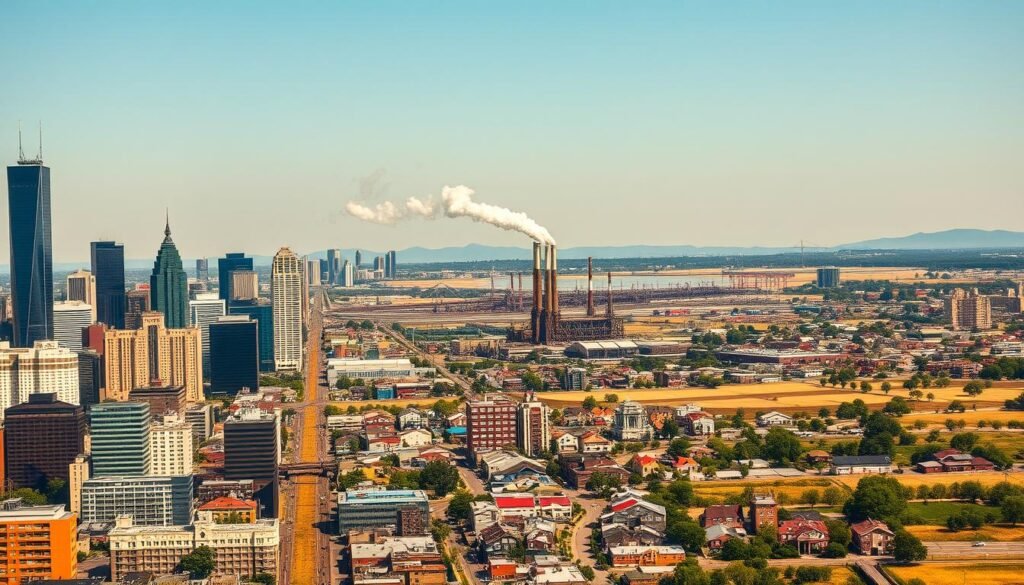Employment Rates in the U.S. show how well the economy is doing. It’s important for businesses, policymakers, and people to understand job market trends. Looking at employment statistics helps us see what affects job growth and decline.
By studying these statistics, we can spot patterns and trends in the job market. This knowledge helps us make decisions that affect the economy and society.

Keeping up with the latest employment statistics is key to understanding the U.S. job market. These rates are linked to the economy, industry jobs, and who is working. It’s important to look at these factors when we analyze job market trends.
This way, we can really understand the job scene and make smart choices about the future of work in the U.S.
Key Takeaways
- Employment Rates in the U.S. are a key indicator of economic health
- Job market trends are influenced by various factors, including economic indicators and industry employment
- Analyzing employment statistics is crucial for understanding the labor market
- Demographic patterns play a significant role in shaping employment trends
- Staying informed about the latest employment statistics is essential for making informed decisions
Current Employment Rates in the U.S.
The job market in the United States is complex and influenced by many factors. To grasp the labor market, we need to look at the latest employment numbers and trends. The health of the job market is closely tied to the employment rates in different industries.
Some sectors are leading the job growth, while others are seeing fewer jobs. The geographic distribution of employment also matters, with some areas having more job opportunities than others. Economic indicators like GDP and inflation rates affect the job market, so they’re important to consider.
- Technology and software development
- Healthcare and biotechnology
- Retail and e-commerce
These sectors are not just creating jobs but also driving innovation and economic growth. By studying the latest employment data and trends, we can better understand the job market. This helps us make informed decisions about the future of work.
Historical Trends in American Job Markets
The job market in the United States has seen big changes over time. These changes were caused by things like economic downturns, new technologies, and policy shifts. Knowing the job market’s history helps us understand today’s job scene.
Important events like the Great Depression, World War II, and the dot-com bubble have shaped the job market. Each event brought its own changes. For example, after World War II, more people found jobs. But the 2008 financial crisis made it harder to find work.
To understand the job market’s history, let’s look at some key data:
- Average unemployment rate: 5.5%
- Longest period of economic growth: 1991-2001
- Most significant decline in employment: 2007-2009
The job market’s history is tied to its evolution. As the economy grows and changes, studying these trends helps predict the future. By looking at past data and understanding what influenced job rates, we can see where the job market is today.
Factors Affecting Employment Growth
Many things affect how jobs grow, like the economy, new trends, tech, and policies. Knowing these helps us guess job rates and make smart choices. A strong economy usually means more jobs.
Several key factors contribute to employment growth, including:
- Industry evolution: New industries can create jobs, while old ones might lose them.
- Technological impact: New tech can replace some jobs but also create new ones, like in software.
- Policy effects: Government actions, like tax breaks or trade deals, can help or hurt job growth.
To understand how these factors affect jobs, look at this table:
| Factor | Impact on Employment Growth |
|---|---|
| Economic growth | Positive: more jobs are created |
| Industry trends | Mixed: it varies by industry |
| Technological impact | Mixed: tech can both replace and create jobs |
| Policy effects | Positive or negative: it depends on the policy |
By looking at these factors and how they work together, we can better understand job growth. This helps us predict future trends more accurately.
Regional Employment Disparities
Regional employment disparities are a big issue in the United States. Different areas face different levels of job availability. The regional employment rates vary due to economic conditions, industry types, and demographics. These geographic disparities greatly affect the job market, causing labor market inequality.
Looking at the data, we see big differences in job rates across regions. Some places have booming industries, while others see their industries decline. This leads to regional employment gaps, where some areas have low joblessness, while others struggle with high rates.
Several factors contribute to these geographic disparities in job rates. These include:
- Economic conditions: Areas with strong economies usually have lower joblessness.
- Industry presence: Places with growing industries tend to have fewer jobless people.
- Demographic factors: Areas with skilled workers often have lower joblessness.

It’s important to understand what causes labor market inequality. By studying these disparities, policymakers can find solutions. They can focus on areas needing help to boost regional employment and reduce geographic disparities.
Demographics and Employment Patterns
Understanding how demographics affect employment is key for businesses and policymakers. In the United States, many factors shape employment patterns. These include age, gender, and education.
Research shows that age affects job roles. Younger workers often start in entry-level jobs. Meanwhile, older workers tend to hold senior positions.
The gender distribution in jobs also matters. Women are more common in healthcare and education. Men, on the other hand, are found more in tech and engineering. Education level also impacts job prospects and pay.
Some important findings on demographics and jobs include:
- Age group analysis: Workers between 25-44 years old have the highest employment rates.
- Gender distribution: Women make up approximately 47% of the workforce.
- Education impact: Workers with a bachelor’s degree or higher have lower unemployment rates.
By looking at these demographic factors, businesses and policymakers can understand job market diversity. This knowledge helps in creating strategies to improve job outcomes and promote diversity and inclusion.
Remote Work’s Impact on Employment
Remote work is now a big deal in the job world. Many companies are starting to let people work from home. This change has made it easier for more people to find jobs.
Working from home can make people happier and save them time on commutes. It also helps them balance work and personal life better. But, it can be tough to stay motivated and feel connected to others.
Thanks to remote work, people can now work in places they couldn’t before. This has opened up new job chances for many. As the job market keeps changing, remote work will likely play a big role in the future.
Here are some important things to think about with remote work and job flexibility: * Working from home can make people happier and more productive. * It saves time and money on commutes. * It helps balance work and personal life. * It gives more people job chances. * It can be hard to stay motivated and feel connected.
Employment Challenges and Opportunities
The job world is always changing, bringing both ups and downs for job hunters and bosses. A big employment challenge is the skills gap. This means workers don’t have the skills employers need. This gap slows down the economy and makes it hard for companies to find the right people.
Industry trends shape job chances too. For example, tech growth has created new jobs like data science and AI. But, some fields are shrinking, leading to job losses. Knowing these industry trends helps people choose careers in growing areas.
New job markets like renewable energy, healthcare, and cybersecurity are on the rise. These jobs need special skills. People with these skills will stand out in the job hunt. To close the skills gap, we need to invest in education and training. This will prepare workers for these new fields.
Here are key areas for future job growth:
- Developing skills in emerging technologies
- Investing in education and training programs
- Encouraging innovation and entrepreneurship
By grasping the employment challenges and chances, we can tackle the skills gap. This way, we can make the most of the industry trends and emerging job markets.
Future Employment Projections
Looking ahead, future employment projections show a big change in jobs. Technology and demographics are driving these changes. Research says short-term forecasts show steady job growth, especially in healthcare and tech.
The long-term outlook looks good, with industry growth in green energy and online shopping. To get ready, we need to think about tech, demographics, and the economy.
Important factors for the future include:
- Technological advancements, like automation and AI
- Demographic changes, like more older people and diversity
- Economic conditions, like changes in global trade and growth
Understanding these factors helps us prepare for the job market. The future of work is exciting and full of chances. By staying updated, we can succeed in this changing world.

Conclusion
The employment rates in the U.S. show a complex and changing scene. We’ve looked at the latest numbers and trends. The future of jobs is shaped by many factors, always changing.
Despite challenges like the skills gap and changes in industries, new job areas are opening up. These offer hope for the future.
Our deep dive into U.S. job trends highlights a few key points. It’s crucial to watch economic signs and predict industry changes. It’s also vital to prepare workers for a job market driven by technology.
By keeping up with these changes, both those making policies and job hunters can find their way. They can seize the chances that the future holds.
FAQ
What are the current employment rates in the United States?
The U.S. job market is slowly getting back to normal after the COVID-19 pandemic. Jobs are growing in tech, healthcare, and online shopping. But, the job scene varies by region.
How have employment rates changed over time in the U.S.?
Employment rates in the U.S. have changed a lot over the years. This is due to the economy, new tech, and policy changes. The country has seen ups and downs, with recessions and booms affecting jobs.
What factors influence employment growth in the United States?
Many things affect job growth in the U.S. These include the economy, new industries, tech, and policies. All these things mix together to shape job chances and challenges.
Are there regional disparities in employment rates across the U.S.?
Yes, job rates differ a lot across the U.S. Some places have more jobs, while others have more unemployment. This is often because of the local economy, industries, and people living there.
How do demographic factors influence employment patterns in the United States?
Age, gender, and education are key in the U.S. job market. Job rates change with age, with both old and young workers. Men and women, and those with more education, also play a big role in the job scene.
How has the rise of remote work impacted employment in the U.S.?
Remote work has changed jobs in the U.S. It has made jobs more flexible and opened new chances for some. It has also made the job market more flexible and adaptable.
What are the key challenges and opportunities in the U.S. employment landscape?
The U.S. job market faces challenges like a skills gap and new job trends. But, these also bring chances for learning new skills and finding jobs in new fields.
What are the future employment projections for the United States?
The short-term looks good for jobs in the U.S., with rates getting better. But, the long-term will see more changes, thanks to tech, demographics, and industry growth. Knowing this helps people and companies get ready for the future.